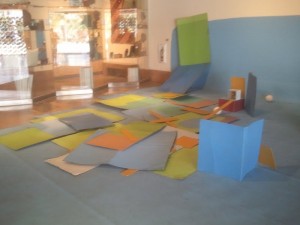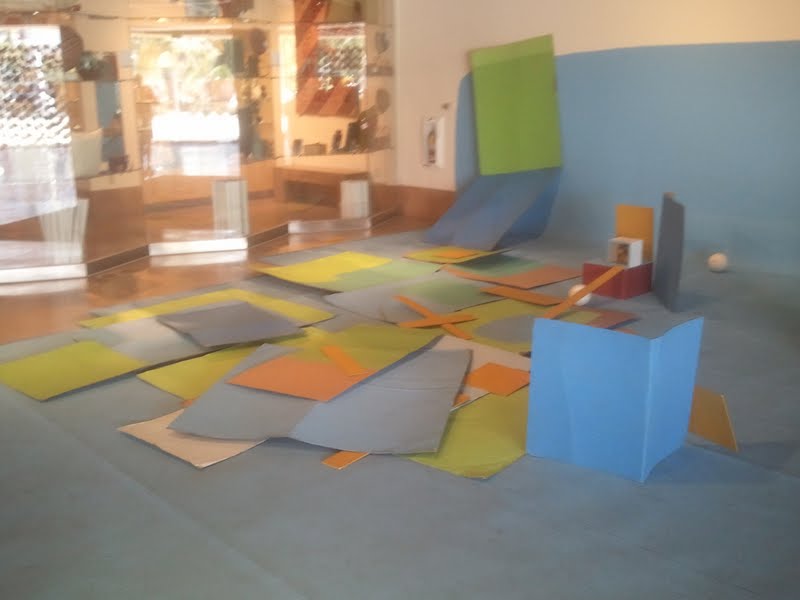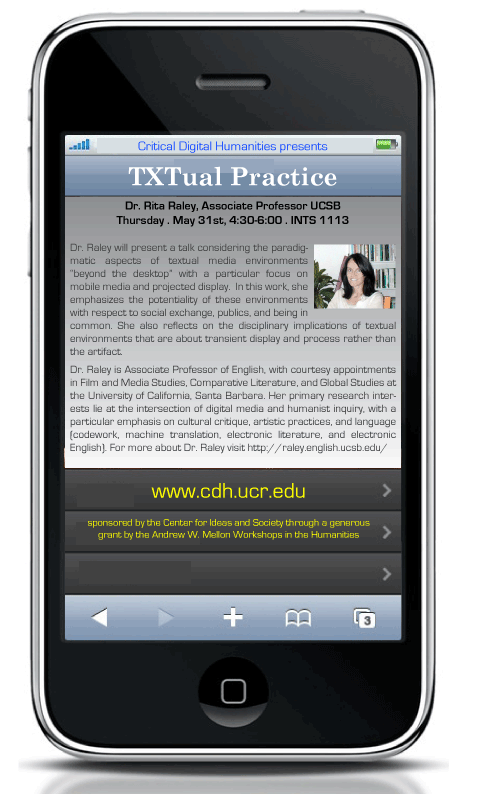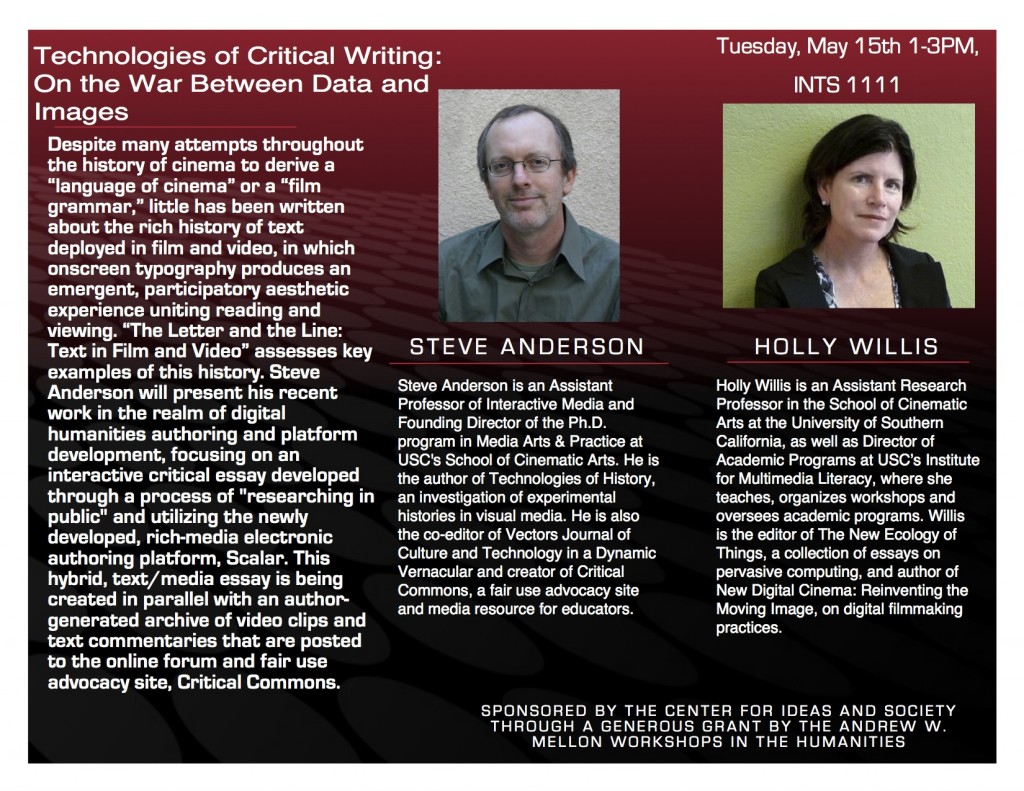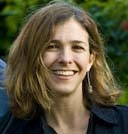Archive for
April Durham . 17 August 2012
Long Beach is about 20 minutes southwest of the crumbly LA neighborhood where I am spending a sticky-baked summer. I am too tired to drive and Pam prefers to pilot anyway. It’s already needle hot when we leave at 10:23 am. The 110 to the 5 to the 60 to the 710. Aquarium exit to Broadway to Alamitos. The parking lot is mostly empty and (finally) a sea breeze teases us toward the door. The space is so professional, so institutionally proper, with excellent air conditioning, gleaming floors, and very quietly polite security guards. The museum avoids the obvious tropes of Latino-ism, tropical frescoes, colorful tile, dense installation. Instead, minimal institutional space sanctions resistance, creating a strange, almost discomfiting celebration the ways in which its constituency creatively reflects on its experience of the world: a globalized, not-particularly-supportive, often-exploitative world.
Why interactivity? The term implies, these days, a high level of technological
interface, a mediating of the “natural” world by the tools of the cyber terrain. But there are only two pieces with an overtly technological structure: Deep Thought V.2, by Dream Addictive, brings to mind boardwalk fortune telling machines, where touching bolt-like “sensors” connect the traveller to a machine that renders thoughts as biofeedback, eventually spitting out a slip of paper with a Spanish interpretation of the imagination. The other involves sitting inside a little oval hut made from egg cartons and waving hands in front of sensors that emit the sounds of the Tijuana streets. Neither of these pieces functions with the slick, fault-proof necessity of the digital interface though. The sense is that they repeat where they should progress or they reset because the physical touch is too tenuous, issuing faults or making frailty and apparatic vulnerability transparent to that of the “natural” human. Fear of too much interface drives the interaction with these works more than a streamlining of the meat-to-machine we’ve grown to expect à la Sleep Dealer.
An air bladder made from pages of An Introduction to Psychoanalysis and  other books by Freud that the viewer can enter, a candy-finish painting the viewer can touch, and a wall of plastic funerary flowers to which the viewer can add. Only uncertainly interactive, these works seem shy and tentative, failing to invite the masterful engagement humans are used to exercising with their digital partners (AKA computers or games). Appearing as traditional sculptures, the viewer hesitates to touch. The guards stand by looking pointedly to see if you will touch, in fact. But beautifully trained, they kindly, gently encourage, lifting edges, coax the shedding of various bits of clothing, soothingly offer instructions on precisely how to interact.
other books by Freud that the viewer can enter, a candy-finish painting the viewer can touch, and a wall of plastic funerary flowers to which the viewer can add. Only uncertainly interactive, these works seem shy and tentative, failing to invite the masterful engagement humans are used to exercising with their digital partners (AKA computers or games). Appearing as traditional sculptures, the viewer hesitates to touch. The guards stand by looking pointedly to see if you will touch, in fact. But beautifully trained, they kindly, gently encourage, lifting edges, coax the shedding of various bits of clothing, soothingly offer instructions on precisely how to interact.
Pressing on the slick sunset finish of Rubén Ortiz-Torres’ painting, you see the shadow of your hand beside that of your friend and then it fades as if you were never there. The nature of this interactivity is not immersive, not consuming in the way a Gibsonian, jacked-in cybersurfer (or an MMORPG player) experiences/becomes. Rather, it is consuming in the way of a penetrating
glance cast by a stranger in a dark public gathering place that catches the receiver in the middle of the chest and is long remembered, even though it was perhaps the most momentary experience of one’s life. The lingering questions: who, why, what… transmitted in the print, the look, the air between ebb and flow through Memory, layered upon the fading imprint of body heat cast by whatever number of viewers dared to touch the same surface.
If interactivity, in today’s online gaming world and even for more pedestrian users like bloggers, vloggers, and social networkers, implies a certain machine-to-human-to-human interaction, with a performative component, the interactive quotient of these works is shockingly “lo-tek.” The concerns of high and low, however, are shared: what does it mean to navigate the political, aesthetic, and social (aren’t they the same in a way?) terrains of shared space/time? Is is possible to witness the “Other’s” sensations/cognitions, material-semiotic struggles, mediated in objects, subjectivities, and histories encountered in the  institutional setting (be that the museum or Google Chrome)? What is the nature of that connection? How to describe it? Faulty, tenuous, vulnerable, pedantic, shrill, violent, contained, noisy, ephemeral, colored, blocked, or elegiac? What about gaps, glitches, non-functionality, errors, obviousness, inelegance, and awkwardness? Does my interface accommodate embarrassment, illiteracy, clumsiness, incompetence? While the stakes in on-line interactivity hinge on these last attributes being ameliorated through the discipline of practice, the works in this show leverage the incapacity of the viewer to prepare her laboring body for skilled engagement. Frailty and inability are prized when succumbing to the floating weight of Freud’s knowledge or the faux-foliage of funerary decor of Alberto Baraya.
institutional setting (be that the museum or Google Chrome)? What is the nature of that connection? How to describe it? Faulty, tenuous, vulnerable, pedantic, shrill, violent, contained, noisy, ephemeral, colored, blocked, or elegiac? What about gaps, glitches, non-functionality, errors, obviousness, inelegance, and awkwardness? Does my interface accommodate embarrassment, illiteracy, clumsiness, incompetence? While the stakes in on-line interactivity hinge on these last attributes being ameliorated through the discipline of practice, the works in this show leverage the incapacity of the viewer to prepare her laboring body for skilled engagement. Frailty and inability are prized when succumbing to the floating weight of Freud’s knowledge or the faux-foliage of funerary decor of Alberto Baraya.
The nest built by Franklin Cassaro of pages from books by Sigmund Freud, taped together with plastic packing material, breathes a welcome to its strange interior. “I could lie in here all day,” says my companion. “Yeah,” I sigh. Highly legible but impossible to “read,” these familiar texts, so important to 20th century thought, culture, and social/psychical understanding float around like a  breathing womb, a lung-abyss that allows in light, receives the air from a rotating fan just outside, but does not encourage exit. Even the kindly young guard who so attentively lifts the edge so you can enter, is nowhere to be found when you want to leave. You have to struggle against the rigidity (however frail) of the tape, and the concern for damaging the already creased and worried edges of the text, to trip out awkwardly and straighten your skirt, and wonder about who might notice your dirty knees. While deliciously inviting, the interactivity solicited by this work is precarious, and if not imprisoning, then certainly sticky and all the more maddening thanks to its beauty.
breathing womb, a lung-abyss that allows in light, receives the air from a rotating fan just outside, but does not encourage exit. Even the kindly young guard who so attentively lifts the edge so you can enter, is nowhere to be found when you want to leave. You have to struggle against the rigidity (however frail) of the tape, and the concern for damaging the already creased and worried edges of the text, to trip out awkwardly and straighten your skirt, and wonder about who might notice your dirty knees. While deliciously inviting, the interactivity solicited by this work is precarious, and if not imprisoning, then certainly sticky and all the more maddening thanks to its beauty.
In the lobby of the museum, Federico Herrero offers the closest thing to immersive interactivity in a piece comprised of old, painted cardboard, little boxes, sticks, and styrofoam balls, all dusty and a bit decrepit. This work  “translates the mix of colors, shapes, and forms of the streets of San José, Costa Rica—and the tropical landscape that surrounds the city, onto gallery walls,” or so says the museum website. The artist offers a little space, like that in a preschool, where components that might be used to make the throw-away artworks that fascinate my friend and me, comprising each of our own art practices (differently but in a shared context) can be moved around at will, bent, walked upon, hidden under, stacked. I reach out and move a stick as we pass by the jumble and a little tower of stuff tumbles over, almost landing on my foot. Interactivity can be dangerous, first lesson. I look to see if the security guard is ready to wrestle me to the ground, but he goes on checking things on a list and ignores me. “Pam,” I whisper. “I think we can play.” Pam, of course, doesn’t need another nudge and begins dealing out slabs of wasted cardboard in various shades of green in piles that appear random but which are governed by her highly honed aesthetic sense. I move some sticks and a ball into a tight grid at one corner. Then I make a little ramp and hope a ball will roll down it.
“translates the mix of colors, shapes, and forms of the streets of San José, Costa Rica—and the tropical landscape that surrounds the city, onto gallery walls,” or so says the museum website. The artist offers a little space, like that in a preschool, where components that might be used to make the throw-away artworks that fascinate my friend and me, comprising each of our own art practices (differently but in a shared context) can be moved around at will, bent, walked upon, hidden under, stacked. I reach out and move a stick as we pass by the jumble and a little tower of stuff tumbles over, almost landing on my foot. Interactivity can be dangerous, first lesson. I look to see if the security guard is ready to wrestle me to the ground, but he goes on checking things on a list and ignores me. “Pam,” I whisper. “I think we can play.” Pam, of course, doesn’t need another nudge and begins dealing out slabs of wasted cardboard in various shades of green in piles that appear random but which are governed by her highly honed aesthetic sense. I move some sticks and a ball into a tight grid at one corner. Then I make a little ramp and hope a ball will roll down it.
We stay here the longest, really playing, really having fun and never at all intimidated, cautioned, or constrained by the fact that we are professional artists, serious women, not-super young, creative urchins lingering between the spaces sanctioned for play and those made political by the kind of gesture exercised within-upon them. We wonder for a moment, loving cardboard, thinking about fish, wishing it could stay this way, desire unmediated in a falling-down structure that is oh so pretty all the same.
crossposted at cyberurchin
CFP: “The History and Future of Data Visualization” (Digital Humanities Caucus)
July 31st, 2012
April Durham
Assistant Professor
School of Literature, Communication, and Culture
Georgia Institute of Technology
Atlanta, GA 30332-0165
lauren.klein@lcc.gatech.edu
A Digital Media and Learning Research Competition on Badging and Badge Systems Development
In March 2012, the Digital Media and Learning Competition on Badges for Lifelong Learning (supported by the John D. and Catherine T. MacArthur Foundation and the Bill and Melinda Gates Foundation) awarded 30 development grants to support the creation of digital badges and badge systems that contribute to, identify, recognize, measure, and account for new skills, competencies, knowledge, and achievements for 21st century learners wherever and whenever learning takes place.
We seek research proposals that support and inform the design, development, and deployment of the digital badges and badge systems in any of these categories:
The Digital Media and Learning Badges for Lifelong Learning general category, which supported the development of badges and badge systems across a diverse range of content, institutions, and approaches.
Project Mastery awards focusing on the efficacy of badging systems for learning at Gates Foundation supported Project Mastery sites (School District of Philadelphia, Adams County School District 50, Asia Society). Project Mastery projects promote learning that is mastery based and Common Core aligned. The aim is to support new learning and knowledge, real-world outcomes like jobs, credit for new skills and achievements, and whole new ways to level up in their life and work.
Teacher Mastery badge projects that track and promote feedback regarding the competencies, skills programs and subjects over which teachers acquire expertise. These include systems for recognizing and rewarding some of the capacities, skills and content needed to effectively teach math, literacy, or digital literacy skills and/or to effectively teach to the Common Core State Standards. n March 2012, the Digital Media and Learning Competition on Badges for Lifelong Learning (supported by the John D. and Catherine T. MacArthur Foundation and the Bill and Melinda Gates Foundation) awarded 30 development grants to support the creation of digital badges and badge systems that contribute to, identify, recognize, measure, and account for new skills, competencies, knowledge, and achievements for 21st century learners wherever and whenever learning takes place.
We seek research proposals that support and inform the design, development, and deployment of the digital badges and badge systems in any of these categories:
The Digital Media and Learning Badges for Lifelong Learning general category, which supported the development of badges and badge systems across a diverse range of content, institutions, and approaches.
Project Mastery awards focusing on the efficacy of badging systems for learning at Gates Foundation supported Project Mastery sites (School District of Philadelphia, Adams County School District 50, Asia Society). Project Mastery projects promote learning that is mastery based and Common Core aligned. The aim is to support new learning and knowledge, real-world outcomes like jobs, credit for new skills and achievements, and whole new ways to level up in their life and work.
Teacher Mastery badge projects that track and promote feedback regarding the competencies, skills programs and subjects over which teachers acquire expertise. These include systems for recognizing and rewarding some of the capacities, skills and content needed to effectively teach math, literacy, or digital literacy skills and/or to effectively teach to the Common Core State Standards.
Click here for full CFP and project information: http://dmlcompetition.net/Competition/4/research-development.php
Please join us for one of the final events of our exciting digital year.
Dr. Rita Raley, Associate Professor at UCSB will present on the possibilities for social exchange in textual media environments, focusing on hand-held devices.
Thursday, May 31
4:30-6 pm
INTS 1113
Refreshments served!
Dr. Raley’s talk will move “beyond the desktop,” with a particular focus on mobile media and projected display. In this work, she emphasizes the potentiality of these environments with respect to social exchange, publics, and being in common.
She also reflects on the disciplinary implications of textual environments that are about transient display and process rather than the artifact. Dr. Raley is Associate Professor of English, with courtesy appointments in Film and Media Studies, Comparative Literature, and Global Studies at the University of California, Santa Barbara. Her primary research interests lie at the intersection of digital media and humanist inquiry, with a particular emphasis on cultural critique, artistic practices, and language (codework, machine translation, electronic literature, and electronic English).
For more about Dr. Raley visit: http://raley.english.ucsb.edu/
UCLA Postdoctoral Position
One-year appointment beginning August 2012; possible renewal for up to two more years. Review of applications begins May 15; submission deadline is May 30, 2012.
We seek a postdoctoral researcher for a three-year research project, entitled The Transformation of Knowledge, Culture, and Practice in Data-Driven Science: A Knowledge Infrastructures Perspective
http://knowledgeinfrastructures.gseis.ucla.edu/index.html
We are conducting ethnographic and interview research about digital data practices among scientists about their research design and data collection, data analysis, data management, and data sharing with colleagues and the public. The project sites are four distributed data-driven research projects, two of which are ramping up their activities and two of which are ramping down.
The project is funded by the Sloan Foundation Digital Information Technology Program. http://www.sloan.org/program/28
The principal investigator is Christine Borgman, Information Studies, UCLA
http://is.gseis.ucla.edu/cborgman/
http://works.bepress.com/borgman/
The co-principal investigator is Sharon Traweek, Gender Studies/History, UCLA
http://www.womensstudies.ucla.edu/faculty_traweek.html
http://www.history.ucla.edu/traweek/
The postdoctoral researcher will participate actively in the collaboration, including the design, conduct, and analysis of interviews and ethnographic fieldwork. The postdoctoral researcher will gain experience in collaborative research, research project organization, and digital data research practices. The project is based at the University of California at Los Angeles (UCLA) and residence nearby is required for the duration of the postdoctoral research appointment. Some travel is required for research and conferences.
We prefer applicants with
* ethnographic and interview research experience, and
* substantial knowledge of research in the interdisciplinary fields of Science, Technology, and Society studies (STS) and Information Studies.
The starting salary is $50,000 per year, plus benefits
http://www.gdnet.ucla.edu/gss/postdoc/pdleave.htm
The work is to be done 12 months of the year, excluding university holidays; the postdoctoral researcher is entitled to 24 paid personal days and 12 paid sick days per year. For further information about postdoctoral appointments at UCLA: http://www.gdnet.ucla.edu/postdocs.html
UAW Local 5810 is the Union for over 6,000 Postdoctoral Researchers at the University of California. http://uaw5810.org/
Submit statement of interest, qualifications, CV, and list of three references to Sharon Traweek traweek@history.ucla.edu
or Christine Borgman borgman@gseis.ucla.edu
http://knowledgeinfrastructures.gseis.ucla.edu/docs/SloanPostdoc_BorgmanTraweek_Announce.pdf
CDH event – Technologies of Critical Writing: On the War Between Data and Images
May 9th, 2012
Steve Anderson
Tuesday, May 15th 1-3pm in INTS 1111
Technologies of Critical Writing: On the War Between Data and Images
by USC professors: Steve Anderson and Holly Willis
Despite many attempts throughout the history of cinema to derive a “language of cinema” or a “film grammar,” little has been written about the rich history of text deployed in film and video, in which onscreen typography produces an emergent, participatory aesthetic experience uniting reading and viewing. “The Letter and the Line: Text in Film and Video” assesses key examples of this history. Steve Anderson of USC will present his recent work in the realm of digital humanities authoring and platform development, focusing on an interactive critical essay developed through a process of “researching in public” and utilizing the newly developed, rich-media electronic authoring platform, Scalar. This hybrid, text/media essay is being created in parallel with an author- generated archive of video clips and text commentaries that are posted to the online forum and fair use advocacy site, Critical Commons.
Orientation for the Designated Emphasis in Book, Archive, and Manuscript Studies
April 27th, 2012
Steve Anderson
Orientation for the Designated Emphasis in Book, Archive, and Manuscript Studies
time and location: May 2nd Noon-1:30
UCR English Department Conference Room (HMNSS 2212)
GSEA invites UCR graduate students for an orientation regarding the new Designated Emphasis in Book, Archive, and Manuscript (BAM) Studies. Dr. Adriana Craciun, from the English Department will provide an overview of BAM and answer questions. This event is open to graduate students from all departments, so be sure to invite colleagues from other fields of study.
If you have questions in advance that you would like to be addressed during the orientation, please email them to Sarah Lozier (slozi@student.ucr.edu) or Anne Sullivan (asull003@student.ucr.edu)
While here in our corner of the net, we are working on figuring out the potentials of “contemporary transmedia theory and practice” including interdisciplinarity and collaboration, the MLA is concerned with getting a grip on the parameters for evaluating digital scholarship and the structures both departments and individual scholars need to support one another. After twelve years, the MLA has issued updated guidelines to address the interdisciplinary, collaborative, and practical aspects of digital scholarship.
Because we require institutional legitimacy to have access to the normal trajectory of an academic career, these guidelines are important and necessary. If we want to be able to make solid arguments with traditionalists like Stanley Fish But as it is important to also be critical of state apparatuses, I would like to point to the ways in which these guidelines tend to contain the very openness that is the potential of this work. Of course I’m not arguing for a reprieve from the intense rigors demanded of any kind of scholarship. But I do find that efforts to understand that comprise lists and limiting language are generally about limiting the unexpected, the chaotic, the weirdness that a field like digital humanities (especially when it includes the critical) is constantly renewing by its very nature.
So while the MLA guidelines are meant, in all consciousness, to support the varied ways digital scholarship can exist and to encourage departments interesting in including digital scholars in their faculty to open themselves up to “invasion” from other disciplines or formats for scholarship that may not include paper publications, it also begins the fencing-in that is the road to “state machine” status (to use a D&G concept) or in other words, it begins to frame the ways in which even such untraditional projects as bizarrely mapped digital archives or interactive, spatial texts can be limited to narrowly defined categories and institutional parameters.
Yes, it would seem so. Or at least, with the help of a team of brilliant researchers made up of humanities and digital technologies scholars, computers can at least be asked to try and differentiate Gertrude Stein texts from each other, from other highly sophisticated western literary works, and from a cookbook. The punchline? One such computer consistently confused Stein’s Tender Buttons with The New England Cookbook, which was highly popular during Stein’s day. While this may not seem like much of an accomplishment to the average humanities scholar (indeed, as someone on the verge of PhD Qualifying Exams, I’d be quite pleased if this were my qualifying task, instead), it represents a significant accomplishment in the digital humanities, and provides compelling evidence for the ongoing use value of computing in the study of literature.
This brief anecdote was a small portion of a talk given several weeks ago by Dr. Tanya Clement, of UT Austin, to the Critical Digital Humanities Research Group at UCR. Sponsored in part by The Center for Ideas and Society Mellon Workshop, the event was entitled “Sounding it Out: Modeling Aurality for Large-Scale Text Collection Analysis.” Dr. Clement presented research from her collaboration with a computing center at UT Austin, a project that creates computer models for analyzing sound in literary texts. It emerged several years ago out of a drive to expand the affordances of digital archives to include models that could recognize and work through texts based on the way we read them, not just based on the ways we’re currently able to upload and store them (images, text, etc). In this case, the analysis sought to understand how we might argue for the meaning of sound in literary works—not simply sound as part of form or delivery, but sound as meaning.
The project leaders created a set of protocols that would allow them to come up with a usable “knowledge representation” of texts based on sound, even taking into consideration the subjective nature of sound. For example, different readers will read the same text quite differently, based on numerous factors including regional dialect, speed, intonation, enunciation, etc. A central question then became how to make the best guess at how a text actually “sounds,” given these considerations.
Dr. Clement and the research team selected as their primary text, which they then put through a series of digital translations, from text to code to representation to “best guess at sound.” Now, this is obviously a serious reduction and is admittedly a paraphrase, so please forgive my skipping over most of the technical details, as it’s quite elaborate and I probably wouldn’t rehash it very faithfully anyways. I can say this much, however—that the poems were cycled first through a program called OpenMary, then SEASR, and then through ProseVis (someone out there (myself not included) is reading this and knows exactly what this means, and is probably excited about it—I hope so, at least). The end result of this process was a series of data maps that allowed not only some fascinating analysis (which I’ll detail shortly), but which also functioned for Dr. Clement and team as “hypothesis generators,” which allowed them to ask questions such as “Do we care about sound in this poem? Does it matter to meaning?”
So I’ll skip now to flesh out the opening anecdote. The researchers entered 9 texts into the database, including Tender Buttons and two other Stein texts, plus the cookbook, some Joyce, the Iliad and the Odyssey, and more. Just to try to make sure the computer focused on sound, and not just noting the repetition of words, they eliminated words themselves from the analysis, focusing on data about the words and phrases, such as part of speech, accented syllables, phoneme, tone, and more. What they found was pretty remarkable.
Stein scholars have charged that Tender Buttons was written to reflect Stein’s domestic pleasures shared with Alice B. Toklas, her partner of many years. Thus, it’s been argued, Stein modeled the poems on a cookbook. As it turns out, when the computer was asked to recognize which phrases and patterns belonged to which of the 9 texts, it identified them correctly with a fair degree of accuracy. However, the text that it confused most frequently for Tender Buttons was The New England Cookbook. It also regularly confused the Iliad and the Odyssey for each other, which should indicate the relatively sound (ahem) results.
In any case, what all this may mean is that sound does mean. In other words, Stein wrote Tender Buttons not merely to evoke a cookbook through food references and word choice, but she made her poems sound like the recipes. As if we needed another testament to the genius that Stein herself so often and roundly proclaimed.
I went through the CDH website here, and I made quite a few revisions. The website was getting a little cluttered, which is a good thing since it’s being used a lot, but it did need some spring-cleaning.
Here’s a quick overview of changes:
→ the main navigation was cleaned up
– the About page is now incorporated into the Members page
→ the News navigation dropdown has been revised
– now the only dropdowns are “events” and “resources”
– all the other categories are still available as a dropdown in the sidebar
→ the Twitter sidebar widgets have been removed
– the CDH Twitter feed was mostly just posts from CDH itself (@UCRCDH)
– and #digitalhumanites can be reached in other ways
→ Links (mostly UCR related) have been moved from the sidebar to the footer
→ a new Calendar page has been added to the site (this is for CDH events)
→ the ability to post from iPhone and iPad WordPress apps has been turned on
Also, I added a new category called “techie stuff” where I’ll post info about updates to this site, as well as other things of interest regarding hardware, software, coding, and the digital engineering culture.
If anything looks weird, or if you can’t find something, or something isn’t working right, please send me an email.

